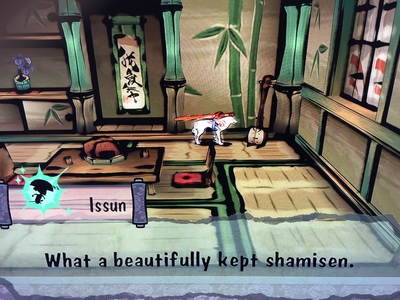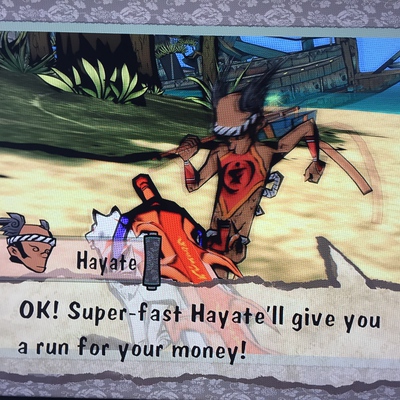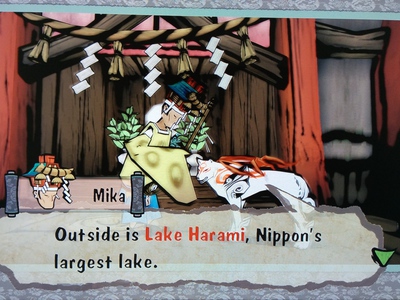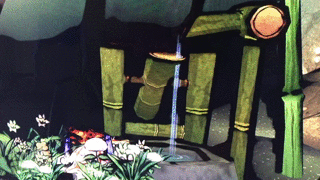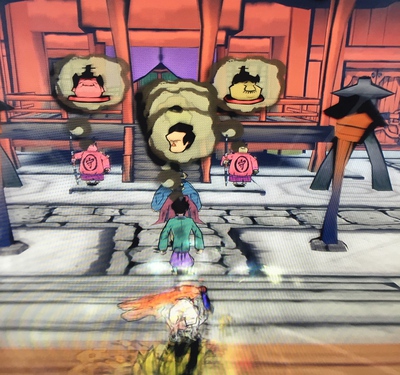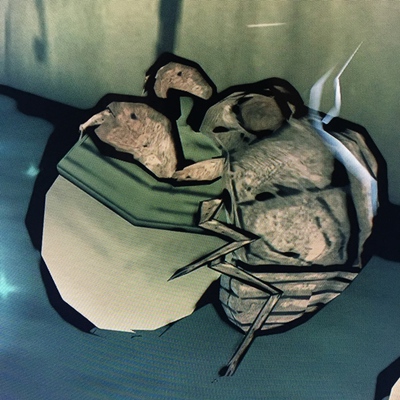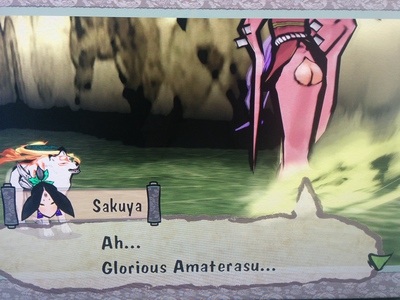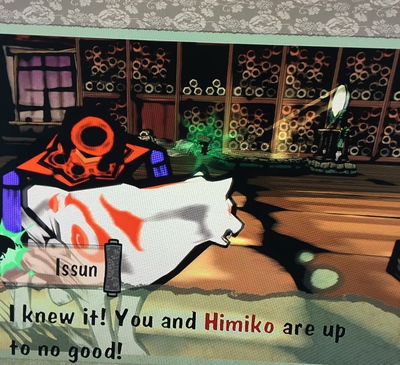Okami is lovely
I’ve been replaying Okami HD recently; coming back to it after several years of not playing made me notice anew all the little details that make the game so great. I really recommend the game on PS3, and I hope they rerelease it on the PS4 or make a proper sequel. I found the game originally because I enjoyed The Legend of Zelda: Twilight Princess and saw Okami listed as being a similar game, at least in so far as you got to play as a wolf. I would say now I prefer Okami to Twilight Princess.
Things I Like
- Interesting mechanic
- The Celestial Brush is really cool. You’d think painting with a regular controller would be hard, but it’s fine, at least for the simple painting you do in Okami. You get pretty fast at drawing slashes, circles, and squiggles to manipulate the world around you. I love that you freeze time when working the Celestial Brush. Dragon Age: Origins is another game that comes to mind when I think of pausing the action to consider strategy. In Okami, the whole screen changes to look like a black-and-sepia canvas with your brush poised over the world. You can rotate the view and find the best angle to slash through enemies, drag fire over to them from a torch across the room, or cover dead grass in ink to revive it. It’s so neat to paint over the world and have it react to your brush.
- It’s beautiful
- Okami is such a lovely game. I played it on the Wii initially and despite the crappy controls, I loved it. I was psyched when it got an HD re-release on the PS3 and I could play with a regular controller. The music, the aesthetic, and the atmosphere of the game are beautiful. It’s a cel-shaded game and everything has a liquid, painted appearance.
It’s also cool as an American to recognize Japanese things I’ve seen in other games, most notably in Animal Crossing. Shops in Okami have a Lucky Cat statue as well as Daruma dolls. I recognize musical instruments that I remember collecting in Animal Crossing. The red rising sun gets splayed across the sky whenever you use your Sunrise technique. Cursed zones have floating kanji hovering in the air.
- Reuse of areas
- It’s cool that areas you traverse at the beginning of the game hold secrets you can only access much later. In one of the first areas you reach, Shinshu Field, there are cat statues that you can’t do anything with, then later you unlock a brush technique that lets you use them. Your traveling companion Issun even comments when you investigate them at first that they have the same vacant expression as you; he doesn’t give any hint that they’re artefacts you’ll later interact with. There are also rocky areas that clearly have treasure buried under them that you can’t get at because your paws aren’t strong enough… yet. Then there’s a crack in the wall that you just know you’ll be able to bust through later. A pond has a swirl in the middle that looks special, though initially you don’t know what it means. All these things are signs to anyone who’s played a video game before that you should come back later when you possess enough skill or the right tool.
Dragon Age 2 did nothing good with its reuse of areas. It suffered from a lack of diversity, and it showed when you’d go through the same cave fifteen times for different quests, and were supposed to believe that half those times you were in a completely different cave in the story, and it just happened to be identical to the one you explored before. Okami has an abundance of different areas, and it never tries to make you think one area is really a different one if they look the same. So when you go to Shinshu Field to lift the curse, then you come back to dig under the rock once you get that skill, then you come back to climb the cliff and call lightning, you’re just exploring further what Shinshu Field has to offer.
- Upgrades
- Going hand-in-hand with the reuse of maps is the progression of new abilities. There are a couple of dojos where you can train and get new fighting techniques as well as improve existing skills. Areas you didn’t realize would ever be accessible suddenly become so because you learned how to double jump. New treasure can be found because you learn how to dig through solid rock instead of just dirt. The mirrors you’ve found scattered around the world that you thought were just used to save your game suddenly become waypoints because you enhanced one of your brush techniques.
The upgrades you can purchase or discover are spread out pretty well; I felt like I was learning new stuff at the right pace. There’s always something tantalizing that you can’t quite afford, too, whether it takes yen in the dojo or more Demon Fangs to trade to a collector. Many upgrades are required to progress the story, such as recovering your lost Celestial Brush techniques, but a lot are optional that you could blow right past if you were in a hurry. I find it rewarding when there’s a lot of optional gameplay; it feels like the developers took their time and considered what different people like to play.
- It feels good
- This game just makes you feel good. The world’s gone to crap because of a giant eight-headed monster, and you’ve got to save it. Poor little animals don’t have enough to eat, so you can buy feed bags for them. NPCs abound with problems ranging from having lost a beloved teacup to needing medicine to cure a sick father. Plants have withered, but you can rejuvenate them and beautify the landscape. Feeding animals, helping people, and restoring the greenery all earn Praise, which is used to level up.
It’s very satisfying to find a blank spot of grass with a monster gate in the middle, then when you defeat the monsters, suddenly trees and a pond and wildlife spring into existence. You’ll also find noxious purple areas with evil-looking kanji floating in midair; once you scribble over them, the ground bursts forth in bloom. One of the ways to heal yourself is to lie down for a while, and flowers grow around you while you nap. Flowers also spring up behind you while you run, getting more vibrant the faster you go.
- Story progression
- Every conversation in Okami involves a cut scene. You know something really important is happening, though, when the art style changes and the narration switches to third person. I liked these moments because it felt like I had accomplished something and could sit back for a second. The world was a bit safer, I had made it to some goalpost.
Okami’s story is crazy because when the game starts you think the big bad guy is Oroshi. Everything is focused on defeating him, and you go through several areas of the world before you finally get to the big battle. Things could have ended there and I would not have been surprised. Instead, after the big fight, you get one of these storyboards and are informed that the story is just beginning. Since the game is so pretty and enjoyable, it’s a treat to see that the show goes on.
- Satisfying fights
- I like the variety of ways to fight monsters in Okami. There are three types of weapons and for each of those you’ll find better models as you progress. There’s Gold Dust that lets you increase the attack power of a single weapon. Weapons behave differently depending on how you’ve equipped them. Then you can use all your myriad Celestial Brush techniques in battle; I found myself using Power Slash, Veil of Mist, and Galestorm the most. Veil of Mist is easy mode: it slows down time for everyone else, and once you have a large enough inkwell (an upgrade you purchase with earned Praise), you can keep time slowed near constantly. Slow down time, wail on the bad guys with your weapon for a bit, maybe knock them out of the air or blow out their flames with Galestorm, and slash them up with Power Slash. Inferno, while powerful, uses a lot of ink, and Cherry Bomb is a little too hard to place while also taking a few seconds to draw.
- Lots of ways to get around
- As you explore the world more and the map opens up, you find numerous ways to get around. Some methods you’ll have to unlock to progress the game, like navigating water routes by drawing lilypads on them, but other methods are purely optional, such as enhancing Veil of Mist to travel via Origin Mirror. Since you’ll revisit areas to move the plot forward, it’s helpful not to have to run all the way back on foot. You can travel via Mermaid Spring and Origin Mirror directly to other Springs and Mirrors in the world. Usually wherever you need to go will have one or the other right in that zone. You also find alternate routes in and out of areas, like you reach Agata Forest via waterlilies on a stream, but you can leave via a tunnel in a cliff.
- Little details
- Every piece of loot you find, every powerup for fights, every collectible has a description. It sounds like such a little thing, but it’s something I appreciated in Dragon Age: Origins and found missing in both Dragon Age 2 and Dragon Age: Inquisition. I think it adds something to a game when there’s a bit of flavor text. It certainly matters in games like The Sims series where there’s a lot of humor to be found in descriptions of furniture you buy. I think it’s nice in Okami, too, where what would otherwise be a trinket you’d barely notice as you pick it up makes you pause because there’s a short summary of what makes it special in the game’s world. “This came all the way from the Dragon Palace? Where’s that? Will I ever see it? It says this statue is posed whimsically? Oh, it is pretty cute, actually.”
There are also objects that have nothing to do with the story, nothing you have to interact with at all to beat the game, but they’re there for you to inspect if you like. Just a little extra to make the world more immersive. Issun will make a comment about this being where Kushi grinds the rice to make sake, or how some small statue must have been there for ages because it’s so weathered. I like seeing small things like this, knowing the extra work that went into them: graphics, the idea of them, the extra translation work, the writing. When they’re not vital to the story, it makes me think they were added because the developers were passionate about the game they were making, which I appreciate.
- No inventory management
- Some games have a very burdensome inventory system. Half my character’s life in Skyrim is spent agonizing over which piece of loot is more valuable so I know which one to leave behind and which one to sell. Okami avoids this problem by not having any kind of inventory limit. You find lots of sake that boosts your attack, slips of paper that boost your defense, fruit that builds up an extra life should you die, and special items that will come into play later. Not to mention all your weapons and the holy items you find that give you unique abilities. It’s a relief to know if you can buy an item, or when you find it in the world, you have room for it.
The lore of the game doesn’t even address storage: you’re a wolf, you don’t wear clothes, you don’t have any kind of backpack on you. You are, however, a god, so maybe that explains how you carry around all your stuff.
- Callbacks to earlier achievements
- You come across challenges in Okami that seem complete on their own, then later it turns out you need the reward you won to solve some other puzzle. I love seeing this kind of thing in books, television, and video games: an idea gets introduced early on, you think “oh okay that’s cool”, and don’t think any more of it. Then a situation arises later and it turns out you’ve had the solution all along, you just didn’t realize.
Sometimes in Okami, a solution to one puzzle winds up solving multiple problems. I stumbled across some moles playing a game in a field, so I joined in. I won the game and got a prize from the mole leader. “Well neat” I thought and went on my way. Then I come across a dude who’s all distraught because the moles stole something from him. Of course, what they stole is the exact item I won from the moles, so I gave it back to him and received Praise plus a different trinket with no obvious use. Since you don’t have to worry about inventory space, the item got tucked away and forgotten. Much later in the game, it turns out there’s another fellow with a different problem, the solution to which is this rare ingredient that he’ll never get his hands on… Except it’s what I had been carrying around for half the game without knowing what to do with it.
A similar thing happens with an old man you meet. You earn some Praise from him, he gives you a bit of info about the area, and reminisces about some girl. Then you get swept off defeating Orochi and you figure that’s all the guy was, a bit of interest added to that particular area. Turns out, you meet the girl he always talked about and you get to reunite the two.
Things I Dislike
- Weird toward women
- There are some straight-up weird interactions with female NPCs in Okami. Issun is the little creature that stays with you the whole game and talks for you, the silent protagonist. He flirts overtly with every woman you meet, in some cases talking about their “melons” and how the lady is so “stacked.” The same lady who seems oblivious when Issun refers to her breasts as melons gets dubbed “Busty Babe.”
There’s some strangeness with your own gender as well. You’re Okami Amaterasu, called both “god” and “mother to us all.” At one point when you have to fight a dog, he says you’re going to fight “man-to-man.” When Issun points out how beautiful each new lady you meet is, Okami gets this awestruck look on her face as both she and Issun go slack-jawed over the woman’s beauty. There’s a skill you can buy that lets you pee on your enemies in battle, and you do so by lifting your leg like a male wolf. I’m not sure if Okami is meant to be androgynous and attracted to women, or if the writers were really just writing as if the player character is male like most adventure games.
- Wordy
- A friend of mine mainly plays arcade-style games because he doesn’t care for story. When a game does have dialogue, he skips through it all. Okami is not a game I would recommend to him. The opening cut scenes take a ridiculous amount of time to get through, in part because the dialogue goes at a set, slow pace and can’t be sped up, unlike most of the conversations during gameplay. Even when dialogue can be sped up or skipped, there’s a lot of it. Issun in particular is a chatty thing, taking several lines to say what could have been said in one.
The game can also be very hand-holdy, showing you a puzzle that looks obvious then, just as you go to solve it yourself, breaking into a cut scene where Issun calls attention to the obvious thing and makes an obvious suggestion about how to solve it. Sometimes I found myself rolling my eyes and wanting to just get on with it.
- Timing puzzles
- I don’t like timing puzzles in any game, and Okami’s can be pretty frustrating. The most frequent kind involves digging underground to lead an NPC to something special on the lowest level. You have to use your brush techniques to get past water, spikes, and blocks. It’s doubly annoying because it’s an escort quest in addition to a timing puzzle: you have to shepherd the NPC along, blowing them over spikes in the floor and flipping them around when they’re going the wrong way. They walk along like a lemming and any time they get hurt, you get seconds removed from the clock.
Some of these digging puzzles are optional, but a couple are required to progress in the game. They always make me gnash my teeth; give me any number of fights or people to save, but spare me the timed obstacle courses. There’s one section of the game that has a series of timed trials that I find super frustrating, and they’re required to get to the end game. I wish those had been omitted entirely or left as an optional challenge to earn extra Praise.
I love Okami and have played it through several times now, despite it being such a long game. When you beat it, you get the option of New Game+, letting you carry over your Praise-bought enhancements and most weapons, which lets you thoroughly trounce enemies and save up to buy even better items the second time around. I come back to the game every couple of years because it’s so satisfying to play. I grit my teeth and suffer through the handful of frustrating puzzles, because the rest of the game is worth it.
